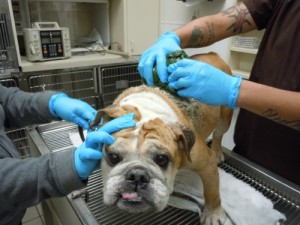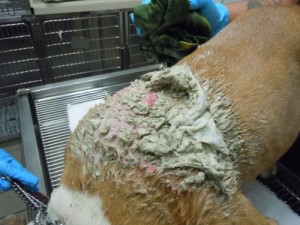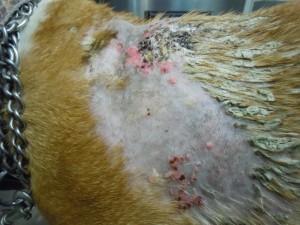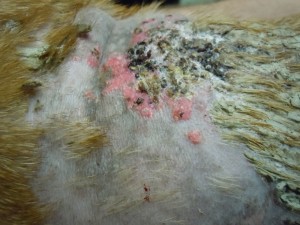By Alfred J. Plechner, D.V.M.
It has been known for many years, that this spider can cause a tremendous amount of tissue damage that can lead to death. These spiders are usually identified by their markings on the dorsal side of their cephalothorax (the upper part of the spiders body). The tell tale marking, is a black line which resembles the body of a violin, with the neck of the violin pointing to the rear of the spider, hence the name Fiddle-back Spider, Brown Fiddler or Violin Spider. The actual name of the genus and species is Loxosceles recluse, better known as the Brown Recluse Spider. It can range in size from 1/4th inch to 3/4th of an inch and sometimes even larger.
Like many species of spiders, they like to reside in generally undisturbed habitats, of which you and your family and pets need to avoid. Try to be very careful around woodsheds, wood piles, cellars, closets, garages and under various structures. Their natural habitat can be in rotting tree bark, but apparently card board seems to attract them as well. In any event, be careful of these areas both for you, the members your family and your pets.
The Brown Recluse Spider was native from the southern Midwest south to the Gulf of Mexico, but now its range has been has become quite extensive and even in Hawaii there is a spider that is the cousin of the Brown Recluse Spider. Interestingly enough, my head technical staff person sustained a bite from this spider as a child in Hawaii and nearly died.
In a 1983 report by Gertsch and Ennik, found the Brown Recluse Spider only occasionally in Arizona, California, Colorado, Florida, Maine, Minnesota, New Jersey, New York, North Carolina, Wyoming and in Mexico. While practicing veterinary medicine at that time, in southern California, I only treated 4 to 5 Brown Recluse Spider bites, while Black Widow Spider bites were much more common at the time. Both types of venom from these spiders are toxic, but in my clinical experience, the Brown Recluse Spider bite causes much more tissue damage, at least in animals.
Only a few years ago, the Brown Recluse Spider population has increased substantially. The first six months of this year while in practice, I have seen more than 25 Brown Recluse bites. It has reached such proportions in certain areas of Los Angeles County, that many land lords have posted pictures of this spider, to warn their new tenants of the inherent danger. I actually had one of these small posters brought to me by a pet owner. She had just rented an apartment in the Silver Lake district of Los Angeles, and this small poster had been placed on the entrance door to her apartment.
Today, September 23, 2010, I had two Recluse bites enter the veterinary hospital with major tissue damage. Often the lesions that the owner or veterinarian see primarily seem minor, but just within one to two days the tissue damage may become catastrophic.
Often the bite will occur on the animal, where the animal sits or lays on the spider. Other times, the bite may occur near the eye, because spiders will go to the person or animal in order to drink the tears. In this case, even if asleep the victim may start to rub their eye and the spider will bite.
In general, most spiders are thought to be poisonous, however many of them do not possess the ability to break the skin. Once bitten by the spider, a small area of redness may occur, leading to a swelling. The animal may bite at the sight and cause hair loss and may be assumed by the owner or veterinarian that this is an area of allergy often referred to as a "hotspot". The pet, whether a dog or cat, may not have ever had a "hotspot" or an area of allergic dermatitis before. Therefore, it is vitally important to ask the owner about the allergy history if any, regarding their pet and take into consideration the location of the allergy or "hotspot".
Even with standard therapy, the swelling and redness may continue to grow in size. Soon the area may become very sensitive because the nerves are now inflamed. As the venom continues its tissue destruction, the toxins can start to cause systemic effects leading to neurological signs, vomiting and diarrhea. Various organs like the liver and kidney can be damaged. A simple blood test will determine if this is happening. Soon, the tissue at the bite site will begin to breakdown and die. As the cellular breakdown fluids are absorbed from the damaged tissue, shock and eventual death may occur.
Clinically, treatment involves the use of steroids and antibiotics, but what is even more effective is the use of a special calcium montmorillonite paste on the bite sight. The dry premium calcium montmorillonite powder is mixed with just enough water to create a paste. The paste is applied to the bite site twice daily for 7 days. This premium calcium montmorillonite paste will not only draw out the toxins, but will also provide a natural antibiotic and will bind any venom remaining at the bite site.
The natural micronutrients contained in this premium calcium montmorillonite will also promote healing while supplying needed nutrients to the damaged skin itself. This premium calcium montmorillonite is also given orally, twice daily at the same time that the paste is applied to the bite site. This will help bind any of the spider venom that's found its way into the general circulation of the patient.
For many thousands of years, healers have used this premium montmorillonite for this specific purpose. You can read about the history and value of the montmorillonite in treating Brown Recluse Spider bites, in a book written by Jason R. Eaton called "Upon a Clay Tablet".
All of my treatments have been successful even in the face of a misdiagnosis using this special calcium montmorillonite. Please GOOGLE premium calcium montmorillinite to find your own source. I know this has given me a successful tool to heal my patients after they have sustained a Brown Recluse bite and I would like to share this tool with you if you are interested.

This is an 11 year old female, spayed, English Bulldog named Mishka.
Her primary diagnosis was an allergic hotpot on her back and standard therapy was applied however after a few days the owner noticed the skin in the area was beginning to literally die.
It was apparent that she had been bitten by a Brown Recluse Spider and the venom from the bite spread well over her shoulders.
 This bite occurred in Beverly Hills California and just one example of how this spider has now begun to inundate our cities.
This bite occurred in Beverly Hills California and just one example of how this spider has now begun to inundate our cities.
This spider is no longer a semi-arid desert dweller and loves to live in tree bark and cardboard containers, so please be aware
The pictures indicate part of Mishka’s therapy with a special clay called calcium montmorillinite.
The owner applied the clay over the bite site and damaged tissue, in order to neutralize the toxins while also giving Mishka this “living clay” internally to further neutralize the spider venom.
 The lesion shows signs of healing and will continue to do so however the return of hair to the area may take up to a year if the hair follicles have not been permanently damaged.
The lesion shows signs of healing and will continue to do so however the return of hair to the area may take up to a year if the hair follicles have not been permanently damaged.
Of interest, during the middle-ages, people bitten by this spider, at that time called a violin spider, based upon the small upside down violin on the upper torso of the spider, almost always died unless they covered the bite site and ingested small amounts of this “living clay” for given period of time.
After 2 weeks of therapy
Copyright ©2013


